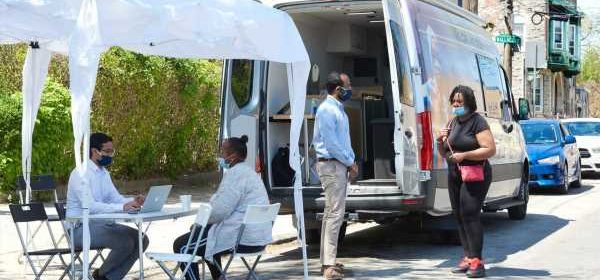Experts warned of the digital divide for years. Now it's 'life or death' as people struggle to sign up for online COVID-19 vaccinations.

- Underserved populations in the US struggle to get COVID-19 vaccines as providers rely on the web.
- About 38 million Americans don’t have internet literacy, and 25 million don’t have internet access.
- The barrier is another way underserved populations are bearing the brunt of the pandemic.
- Visit the Business section of Insider for more stories.
Newly minted college graduates Jay Shah and Santosh Nori started a mobile health-care clinic in October 2019, using a van to provide care to the homeless and low-income population in Philadelphia.
Neither could have predicted how the need for such a service would quickly grow. Just months after beginning work out of the van, called the Sayre Mobile Clinic, the COVID-19 pandemic hit the US. Those without an internet connection or a computer struggled to get to the doctor or refill prescriptions as healthcare, like many other aspects of life, largely moved online.
People experiencing homelessness already face disparities in the healthcare system, Shah said. “And one of the things Covid-19 did was exacerbate a lot of those disparities because they don’t have access to technology.”
The COVID-19 vaccine rollout is the latest to move to the web. Health systems across the US have streamlined the vaccine rollout through the internet. But those without internet access, or even more so, without a lot of time or internet savvy, are struggling to get in line for their shots. The people who lack access and time to sign up for the vaccine are the same as those most at risk for contracting and dying from the disease: minorities, homeless, and elderly Americans.
“It certainly is a life or death situation,” said the Kaiser Family Foundation’s Cynthia Cox in an interview with Insider.
Those experiencing homelessness or food insecurity often don’t have high-speed internet, a computer, or sometimes even a reliable phone, Nori said, and because of that “a majority of that population is essentially elbowed out of the vaccine accessibility and distribution process.” Without the van clinic, he said, the 250 people in Philadelphia’s low-income population who have received vaccine doses so far likely wouldn’t have had access.
Black and Latino Americans, who are over-represented in the US low-income population and in essential-worker roles, have been two to three times more vulnerable to severe COVID-19 cases and deaths. But they haven’t received their share of vaccine doses, according to data from the Centers for Disease Control and Prevention and Kaiser Family Foundation.
The disparity is in part because of the digital divide, in which 25 million Americans lack internet access, according to the Kaiser Family Foundation. Within that divide, Black and Hispanic people lack internet access at higher rates than white people, the data show.
The problem stems from an absence of broadband connection in parts of the country, a lack of the technology to use internet, or a deficiency in internet know-how. But for many low-income individuals, having internet is “often a decision between internet access and electricity,” said Mei Wa Kwong, the executive director of the Center for Connected Health Policy.
Even with internet access, almost 32 million American adults don’t have sufficient knowledge to navigate a computer, according to a 2018 report from the Department of Education.
To sign up for the COVID-19 vaccine, people need a huge amount of web savvy. They must check various websites, such as the state’s Department of Health, local medical nonprofits, Twitter, hospitals and doctors’ offices, pharmacies, and more to find out if they’re eligible and where they can receive it.
“People are spending hours out of their days trying to figure this out or trying to be first in line,” Cox said. “It’s not just about access to the internet; it’s about access to time to spend on the internet. People who are busy working or taking care of kids may not have the ability to sit online all day trying to navigate various websites.”
In an interview with Insider, Dr. Kent Bream, clinical medical director of the Sayre Health Center in Philadelphia, recalled one friend who stayed up until 2 a.m. to sign up for a vaccine appointment at Rite Aid. Individuals need “unlimited internet access and a job that will be flexible” in order to sign up for an appointment, he said.
“People who are experiencing homelessness, even if they have technology, absolutely cannot navigate what is needed to get through the lines,” Bream said. “They do not have the resources to play a technology game.”
In many cases, Cox said, people need an advocate. Her older mother-in-law received her vaccine with the help of her daughter, who signed her up on the internet. Kwong said she took the liberty of signing her parents up online as well. But, Cox said, not everyone has an advocate, and that often leaves behind minorities and low-income individuals.
That’s why medical facilities need to focus on meeting people where they are, said Bream.
“When we frame health disparities as hesitancy, and non-adherence, and non-access, we’re not thinking about being in the wrong place for the people in need,” Bream said.
With regard to the pandemic, he said, “Technology was the solution for everybody who knew how to use technology, who had the fluency with using it, and the ease with using it.”
The Black Doctors COVID-19 Consortium in Philadelphia, one group looking to help reach underserved populations, is hosting a “Vaxathon” this weekend, offering free testing and vaccinations for those who qualify.
Get the latest coronavirus business & economic impact analysis from Business Insider Intelligence on how COVID-19 is affecting industries.
Source: Read Full Article
